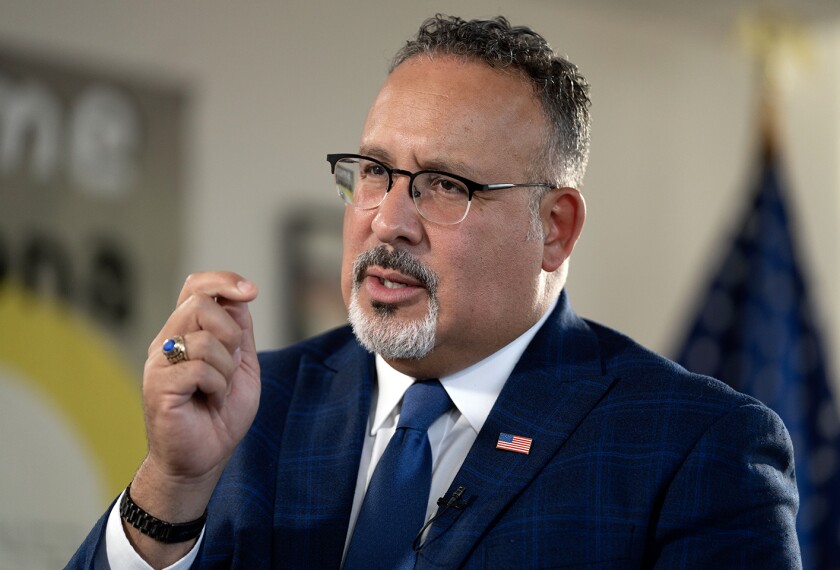Educators across the country should expect a disruption on Wednesday, Oct. 4, as the Federal Emergency Management Agency tests its emergency alert system.
Starting at approximately 2:20 p.m. EST, all cellphones across the country will sound an alarm and display a message reading, “THIS IS A TEST of the National Wireless Emergency Alert System. No action is needed.” All radios and televisions will broadcast a similar message at that time as part of a concurrent test of the national Emergency Alert System and people with phones set to Spanish will see the message in Spanish.
The test is the second of its kind for the National Wireless Emergency Alert System, and it’s the first to be sent to all cellphones without requiring user permission first, a senior FEMA official said in a call with reporters on Tuesday, Oct. 3. The alert will go off at 1:20 p.m. CDT, 12:20 p.m. MT, and 11:20 a.m. PST.
The message will display for 30 minutes, but phones will only play an audio tone, similar to that of an Amber Alert, at the start of the 30-minute window. On most cellphone models, that tone will stop as soon as users click a button, according to FEMA. Phones that are off throughout the 30 minutes won’t receive the emergency message.
The alert will likely cause a disruption in classrooms that allow students to have cellphones on. Classrooms where students are required to turn phones off may also encounter the disruption if students have left their phones switched on. Because of that, teachers and school leaders may want to start Wednesday by reminding students that the alert will be happening, said Amanda Lenhart, head of research at Common Sense Media, a nonprofit that examines the impact of technology on young people.
“The phones are there, they’re in school,” Lenhart said. “Having everybody know that this is coming so that people aren’t surprised is probably right now schools’ best bet given the current environment in schools with the sort of complicated presence of smartphones.”
The emergency alert will be one among hundreds of notifications that students receive on their phones during the day, according to Common Sense Media’s research. In a recent report, the nonprofit found that teenagers receive a median of 273 phone notifications a day, with nearly 25 percent of those coming during the school day. Some students receive as many as 500 notifications in a given day.
On the East Coast, the emergency alert test will happen either late in the school day or after classes have let out. But the tone will sound during prime instructional time in earlier time zones.
While all notifications, regardless of their purpose, can be distracting in the classroom, the emergency alert test should be the least of teachers’ concerns, Lenhart said. Students are much more likely to be distracted by notifications to which they feel a personal connection, such as social media messages from friends.
“There’s the kind of notification that’s easy to ignore, like the system notification like the one that’s going to come,” Lenhart said. “There are also notifications that fall into a similar category, which is social media platforms that you use, which are sort of trying to make a desperate bid for your attention but in ways that are not that appealing to you as an adolescent. … Notifications that represent people you like, people you care a lot about communicating with you about things that are important to you that often happen on places like Snapchat [are] really difficult [to ignore].”
A potential opportunity for learning
In a call with reporters, a senior FEMA official suggested that schools use the emergency alert test as an opportunity to teach students about national emergencies, emergency preparedness, and the value of emergency alerts.
In the lead-up to the test, untrue conspiracy theories have circulated across the internet, claiming that the test will activate nanoparticles injected into bodies through vaccinations that allow governments to control and monitor people, according to the Associated Press.
The claims aren’t true, and there’s no evidence to back them up. The alert is a routine safety procedure that happens every three years. FEMA and the Federal Communications Commission use the test to ensure that the government is able to communicate important information about emergencies when they happen.
Teachers can use the alert as a reason to talk about how government initiatives and safety procedures can become embroiled in misinformation and conspiracy theories. Teachers may want to use the test as an opportunity to talk about why misinformation spreads and how students can develop digital literacy skills.
Common Sense Media provides a digital citizenship curriculum, which includes lessons on how to distinguish credible and trustworthy information sources on the internet from others.
“It’s a brief moment in the school day and I think creative educators who know what’s coming can think about ways to talk about it and integrate it,” Lenhart said.






